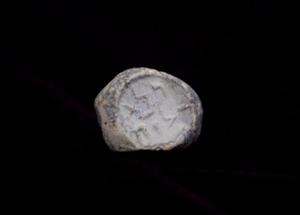
7.1.2011 Ancient seal associated with Jewish rituals
Categories: Calendar , Nálezy nejenom s detektorem na blízkém východě
 A tiny clay seal found beneath Jerusalem's Old City is the first discovery proving religious life inside Jerusalem's Temple Mount 2,000 years ago. The seal was found near the back wall and has two Aramaic words on it that translate to "pure for God." According to archaeologists, this clearly shows that rituals took place in Solomon's hut 2,000 years ago.
A tiny clay seal found beneath Jerusalem's Old City is the first discovery proving religious life inside Jerusalem's Temple Mount 2,000 years ago. The seal was found near the back wall and has two Aramaic words on it that translate to "pure for God." According to archaeologists, this clearly shows that rituals took place in Solomon's hut 2,000 years ago.
Archaeologist Ronny Reich of Haifa University said the seal dates from between the 1st century B.C. and 70 A.D. That's when Roman forces put down a Jewish revolt and destroyed the Second Temple in Jerusalem. "This is really the first discovery of a seal from this period. So for us it is a unique artifact," Reich emphasized.
Archaeologists say the seal was probably used by temple officials who approved items for ritual use. For example, it was oil or an animal intended for sacrifice. The site where the seal was found is on a route that ran through ancient Jerusalem just outside the temple complex.
According to archaeologist Aren Maeir, the seal is referred to in the so-called Mishnah, which refers to a collection of Jewish instructions. "It's nice when we find things that are discussed in ancient sources," he thinks.
We wrote about the seal here: The Seal of Jerusalem

The Ritual Bath
A few days ago, archaeologists discovered a 2,000-year-old ritual bath, or mikveh, in Jerusalem near what was believed to be the site of a biblical garden. According to a statement by Israeli scientists, while exploring an old Byzantine church near the foot of the Mount of Olives, they came across a shaft underground.
This area was supposed to be the location of the legendary Garden of Gethsemane, where Jesus and his apostles watched and prayed the night he was arrested and later. "The newly discovered bath represents the first physical archaeological evidence of activity at this site during the so-called days of Jesus," the archaeologists said.
The mikveh remains part of Jewish culture today as a way to ritually "purify" oneself. Hundreds of historic ritual baths are scattered across Israel. Most are located in private homes and public buildings.
Source: www.dailymail.co.uk, www.smithsonianmag.com
The article is included in categories:
- Archive of articles > Calendar
- Archive of articles > Archaeology > Finds and rescue research abroad > Nálezy nejenom s detektorem na blízkém východě
Post
"=prvním= nálezem dokazující náboženský život uvnitř jeruzalémské Chrámové hory před 2000 lety". Asi bych měl ty pětikorunu, co jsem našel na Václaváku, donýst archeologum. Protože dokazuje, že včera byla Praha obývána lidmi.
Pro někoho bude lepší, když se bude zaobírat internetovou diskusí o Babišovi. Toto není pro každého... 







